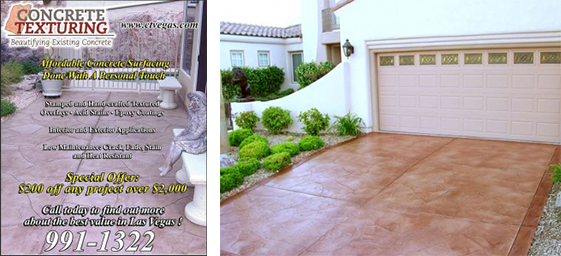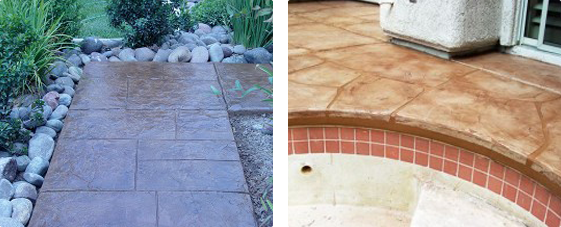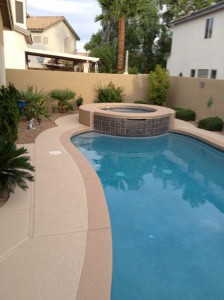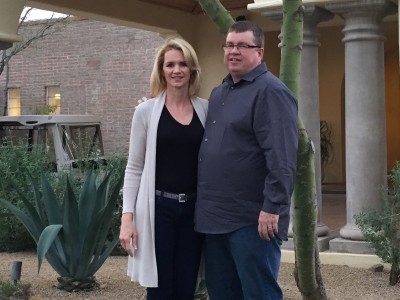
Selecting a Concrete Look
We see decorative concrete everywhere: casinos, interior floors, countertops, driveways, walkways, balconies, patios, and pool decks. It adds so much to the look of a home or business that many areas don’t look finished without it.
You may be thinking about decorative concrete installation for your own home. Well, there are lots of options out there, especially here in the Las Vegas valley. Since this is an investment in your home, you’ll want to make an informed decision.
Concrete surface options have multiplied exponentially over the last 10 years. Years ago, gray concrete was the standard. If you didn’t want standard gray concrete, you had to rip up the concrete and re-pour it. Thankfully, ripping up your concrete is no longer necessary, as there are limitless options to upgrade with texture, stains, and designs that go right over your existing concrete.
This means that instead of that boring gray concrete, you can enjoy the upscale look of classic stonework, tile, or simply rich texture and color. These options have been tested extensively in various conditions for over 20 years. When applied correctly and under the right conditions, these concrete installations have proved to be incredibly durable.
Refresh your Sealant
Sealant questions are common among Las Vegas homeowners, and for good reason. The climate here is intense and can be damaging to surfaces if they’re not adequately protected. No matter what your design preference, maintaining your new surface is key to enjoying it long-term. A properly applied concrete sealer can enhance the look and prolong the life of any decorative concrete surface. This includes stamped concrete, overlays, epoxy rock, stains, and more.
Decorative concrete floors must be maintained by periodically applying a fresh coat of concrete sealer. Knowing when to reseal your surface depends on many lifestyle factors, as well as sun exposure, and the type of sealant originally applied. We advise customers to pay attention to their surface when cleaning it. If water beads up on the surface, you still have a good seal coat. However, if water immediately penetrates the surface, it is time for resealing.
The dangers of not maintaining a fresh seal coat are significant, and include:
- Staining
- Water damage
- Fading color
- Product deterioration
- Bubbling
- Cracking
- Peeling
What You Should Know About Sealants and Contractors
The challenges you face as a homeowner are knowing when you should reseal your decorative concrete floors, and who should do it. This may not be as straightforward as it seems. We know a lot of contractors who steer clear of resealing someone else’s work because there is just too much risk of failure. There are many sealants on the market today that are not compatible with each other, leading to the risk of bond failure.
Precautions must be taken before sealing your concrete floors, such as sealing a test area first. However, even if that test area works, it does not assure the new sealant will bond or react over time with the existing surface. Your best option is to reseal with the same sealant brand. Consequently, you should ask any prospective contractor if he maintains his own product prior to hiring him. We also suggest getting the manufacturer name, number, and local supplier. We also recommend storing the sealant in a safe place in case the contractor goes out of business.
Not all Sealants are Created Equal
If homeowners plan to reseal the surface themselves, we advise getting products from local specialty stores that service the concrete coating industry rather than a hardware store. There is a big difference between commercial-grade concrete sealers and those you can pick up at the hardware store. You should also know what type of sealant is being applied to your surface upfront. A good contractor will ask the customer their preference in sheen and should have an understanding of traffic and use of the surface.
There are two types of sealants: water-based and solvent-based. Solvent-based sealants are much stronger and more durable. They range in durability based on their composition and the percentage of solids in the sealant. For instance, sealant can be a solvent-based acrylic mixture or a solvent-based polyurethane mixture. The polyurethane sealants tend to be more durable, shiny, and stain-resistant than solvent-based acrylic sealants.
Pay attention to the percentage of solids in the sealant. The higher the solids content, the more durable the sealant. For example, a sealant with a 65% solids content will give you more protection than a sealant with a 25% solids content.

The sealant we recommend to our customers varies based on:
- Preferred sheen
- Use of the surface (driveway, patio, business, etc.)
- Maintenance required
Pick Your Shine
If a homeowner doesn’t like a high-shine surface, I steer them away from polyurethanes unless we’re sealing a driveway. Polyurethanes are always a consideration for driveways, which are subject to car traffic and potential oil spills, as they clean up easier than solvent-based acrylic sealants. Since polyurethanes applied over an acrylic stain tend to be extremely glossy, we can decrease the high shine by staining the surface with pigment rather than an acrylic stain. This allows the polyurethane to absorb into the texture, creating a semi-gloss surface.
Again, not all polyurethanes are created equal. There are single-component urethanes and two-component systems that are mixed on-site. The two-component systems tend to cure harder, making them more durable and resistant to stains caused by tires and oil. For high-traffic areas like driveways or commercial properties, a high-build, two-component polyurethane sealant is recommended.
Knowledge is Power
By asking the proper questions, getting referrals, and looking at previous jobs, you can feel confident about the investment you’re making. Remember that keeping your decorative concrete properly sealed will enable you to enjoy your beautiful surfaces for years to come.






